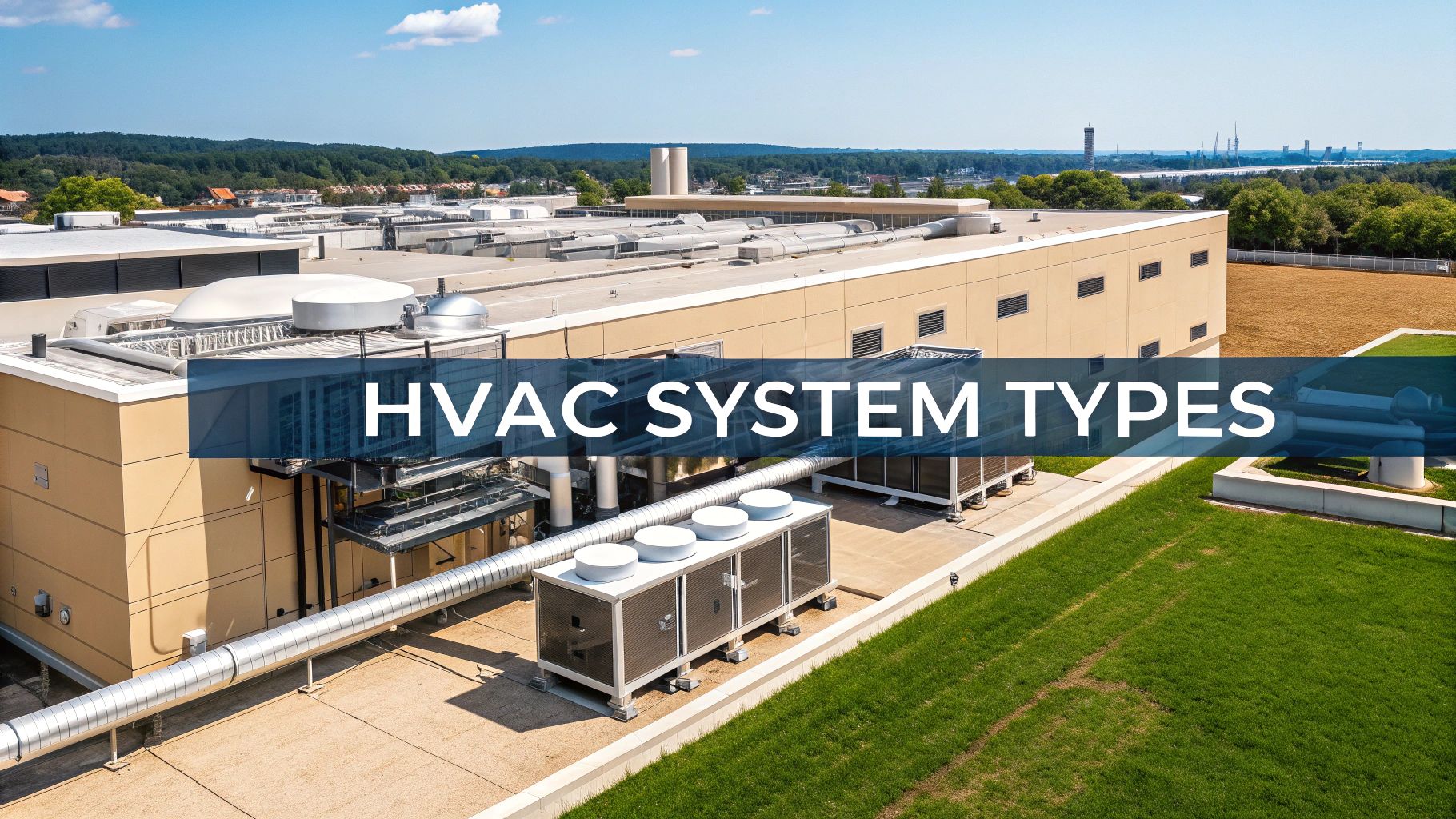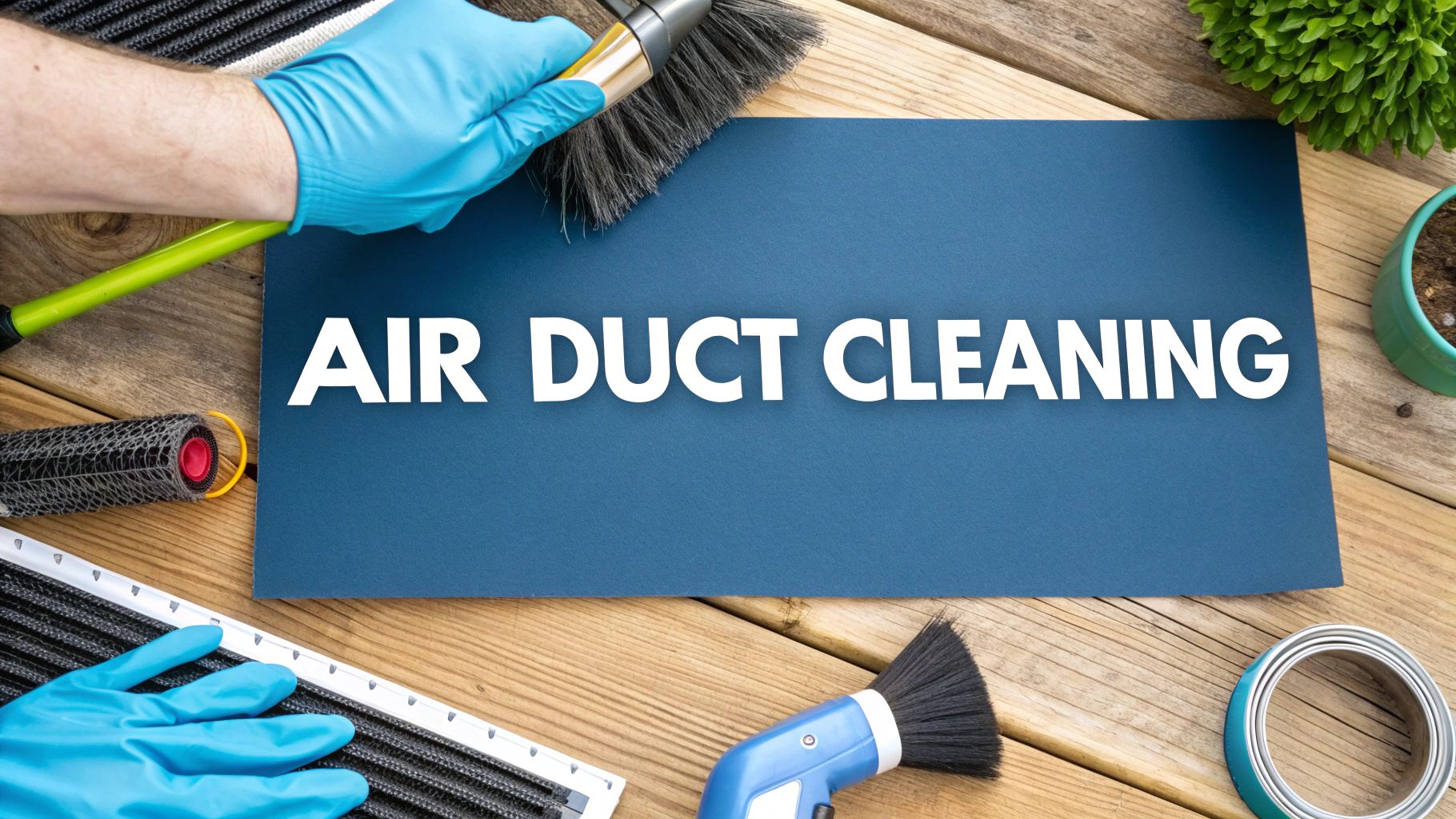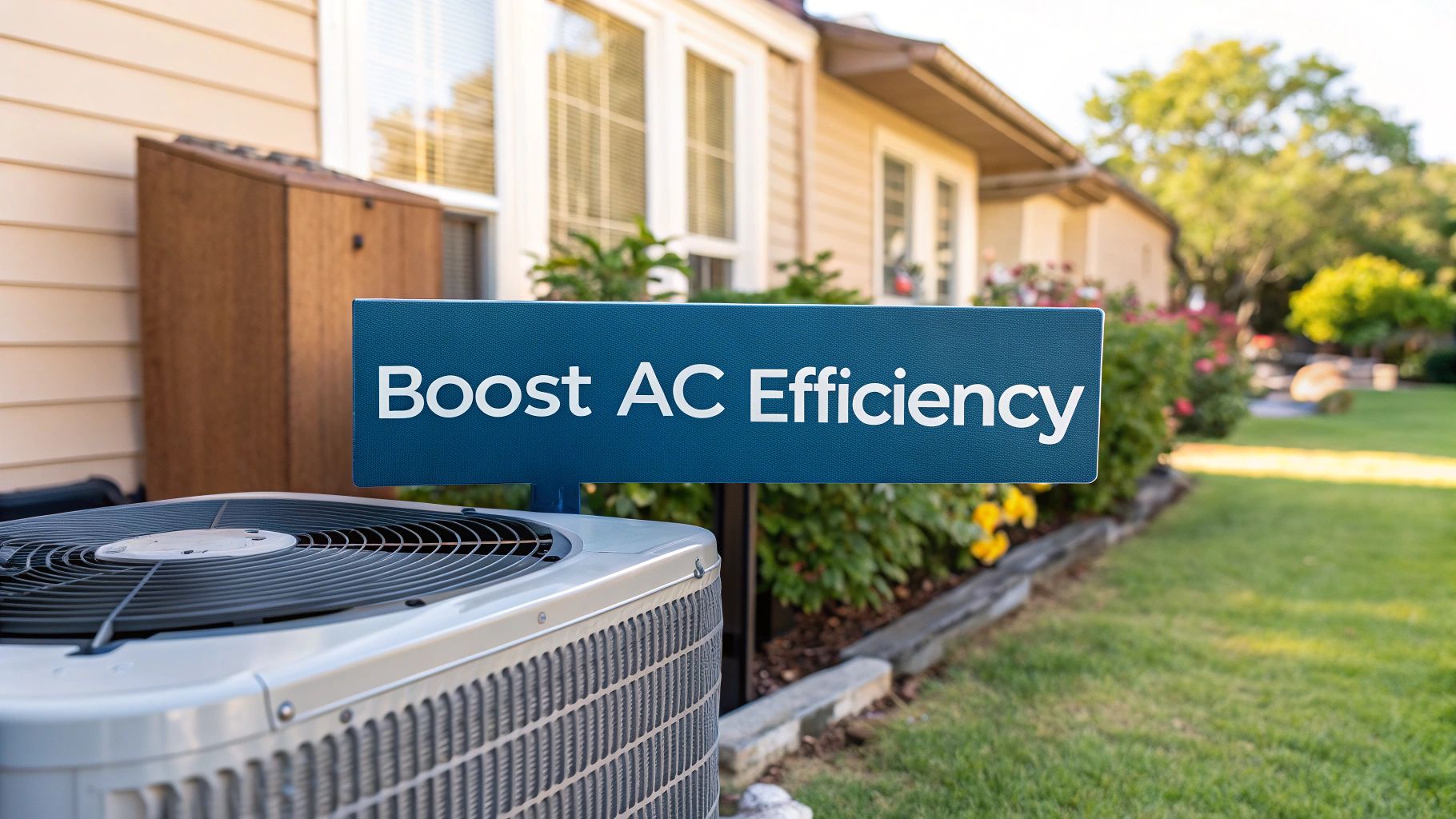When it comes to commercial HVAC systems, the options can seem overwhelming. You've got everything from simple single-split units perfect for a small office to highly complex VRF systems designed for massive buildings. For big, open-plan spaces, you'll often see packaged rooftop units. The key is figuring out which one fits your building's size, layout, and what you're trying to achieve with energy efficiency. This guide is here to cut through the jargon and help Florida businesses make the right call.
Choosing the Right HVAC for Your Business

Picking a commercial HVAC system is one of the biggest infrastructure decisions you'll face, especially with Florida's non-stop heat and humidity. This isn't just about comfort—it's a choice that directly hits your operating costs, energy bills, and even how productive your team is for years to come.
Think of it less like buying a simple appliance and more like investing in the heart and lungs of your building.
The goal is always to match the system to your specific space. If it’s too small, it will run constantly, struggling to keep up while your energy bills skyrocket. Go too big, and the system will short-cycle—turning on and off too quickly. This wastes energy, creates humidity problems, and causes unnecessary wear and tear on expensive components.
Understanding the Market and Your Options
The push for energy efficiency is driving huge growth in the commercial HVAC market. In fact, it's projected to jump from $72.03 billion in 2025 to $106.02 billion by 2032, largely thanks to new green building standards. This just goes to show how critical it is to choose a modern system that will keep you compliant and efficient down the road.
As you start exploring, it's a good idea to get a solid understanding the differences between Heat Pump and AC systems, since they are the building blocks of most commercial setups.
We'll break down the main types of commercial HVAC systems you’ll encounter, using simple analogies to make sense of it all. We’re going to cover:
- Single-Split Systems: Perfect for cooling a single room or a small storefront.
- Multi-Split Systems: Great for when you need different temperatures in different areas.
- VRF/VRV Systems: The high-efficiency choice for large, multi-story buildings.
- Packaged Rooftop Units (RTUs): The workhorse for warehouses and big-box retail stores.
By the end, you'll have a much clearer picture of these options and be ready to make a smart investment that truly pays off.
Getting to Know Single-Split HVAC Systems
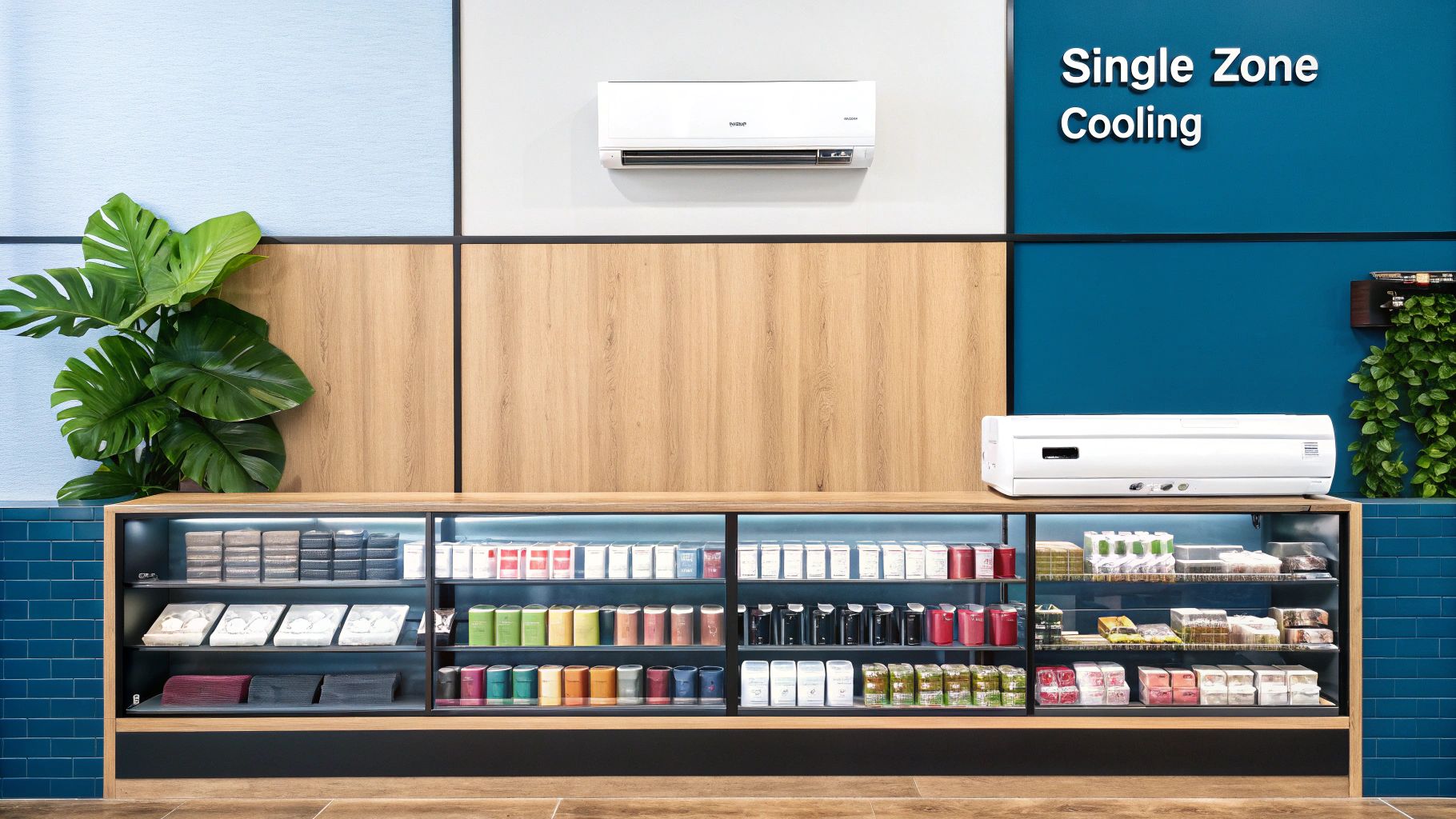
When you start looking at commercial HVAC systems, the single-split is the most common and easiest to understand. Just think of it as a personal air conditioner for one specific room or zone. It’s a straightforward setup: one outdoor unit connects directly to one indoor unit. That's it.
This one-to-one relationship is the whole concept. The outdoor unit (with the compressor and condenser) does the heavy lifting of getting rid of heat. Meanwhile, the indoor unit (with the evaporator coil and fan) grabs heat from the air inside and pushes cool air back out. This direct, simple connection is why you see them everywhere in smaller commercial spaces.
Because of this design, you get total, independent control over that one area. This makes single-split systems a fantastic choice for places with unique climate needs, like a small shop, a single office, or a server room that needs to stay cool 24/7, no matter what the rest of the building is doing.
How Do They Actually Work?
The process is refreshingly simple. When you adjust the thermostat, the indoor unit starts pulling in warm air from the room. This air flows over a super-cold evaporator coil, and the refrigerant inside the coil soaks up the heat, turning from a liquid into a gas.
That gas then gets pumped to the outdoor unit. Here, the compressor squeezes it under high pressure, making it very hot. This hot gas then moves through condenser coils while a fan blows air over them, releasing all that captured heat outside. The refrigerant turns back into a liquid, and the whole cycle starts over, keeping your space consistently cool.
The real beauty of a single-split system is its simplicity. Because it only handles one zone, you don’t need a maze of ductwork or complicated controls. This makes the initial installation much, much cheaper.
For a Florida business owner who just added a new office or needs to cool a standalone kiosk, this system is a direct and cost-effective fix. You get the cooling you need right where you need it, without touching your existing HVAC setup.
The Good and The Bad for Your Business
While single-splits are great for specific jobs, they aren't the answer for every situation. It’s important to weigh the pros and cons before you commit.
Pros and Cons for Your Business
While single-split systems are effective, they aren't a one-size-fits-all solution. Understanding their benefits and limitations is crucial before making a decision.
Key Advantages:
- Lower Initial Cost: Compared to bigger, more complex systems, the upfront price tag on a single-split unit is much easier to swallow.
- Independent Control: You get precise temperature management for one zone. What you do in the server room won't affect the reception area.
- Simple Installation: No need to tear up walls for extensive ductwork. This means a quicker, less disruptive installation process for your business.
Potential Drawbacks:
- Inefficient Scaling: Need to cool five separate offices? You'll need five separate single-split systems. That means five outdoor units, which gets expensive fast and can really clutter up the outside of your building.
- Limited Capacity: These units are built for smaller, defined spaces. They just don't have the muscle to cool a large, open-plan warehouse or a big retail floor.
- Aesthetic Impact: A row of outdoor condenser units can be an eyesore. Depending on your property, it might even violate building codes or HOA rules.
In the end, a single-split system is the perfect tool for a very specific job. It's the go-to solution when you need to solve an isolated cooling problem quickly and without breaking the bank. But if your building has multiple rooms or large open areas, you'll want to look at other options that offer better scalability and long-term value.
Exploring Multi-Split Zoned Climate Control
If you like the idea of a single-split system but need to cool more than one area, the multi-split is the logical next step. It takes that core concept and expands on it, offering a huge boost in flexibility for commercial spaces.
Think of it like this: one powerful outdoor unit acts as a central hub, connected to several individual indoor units. This setup is perfect for businesses that need more than a one-size-fits-all approach to climate control. You can create different temperature “zones” all over your building—a real game-changer.
How Zoned Climate Control Works
The big idea here is efficiency through consolidation. Instead of plastering the outside of your building with a separate outdoor unit for every indoor one, a multi-split system needs just one. That single outdoor unit is powerful enough to handle the heating and cooling for up to five separate indoor units at the same time.
From that central hub, refrigerant lines run to each indoor unit. And you can even mix and match the types of indoor units. You could have a sleek wall-mounted unit in one office, a discreet ceiling cassette in a conference room, and a concealed ducted unit in a lobby. It's all about tailoring the system to your space without creating a mess on your building’s exterior.
This image really drives home how one outdoor unit can manage multiple zones, giving each its own thermostat.
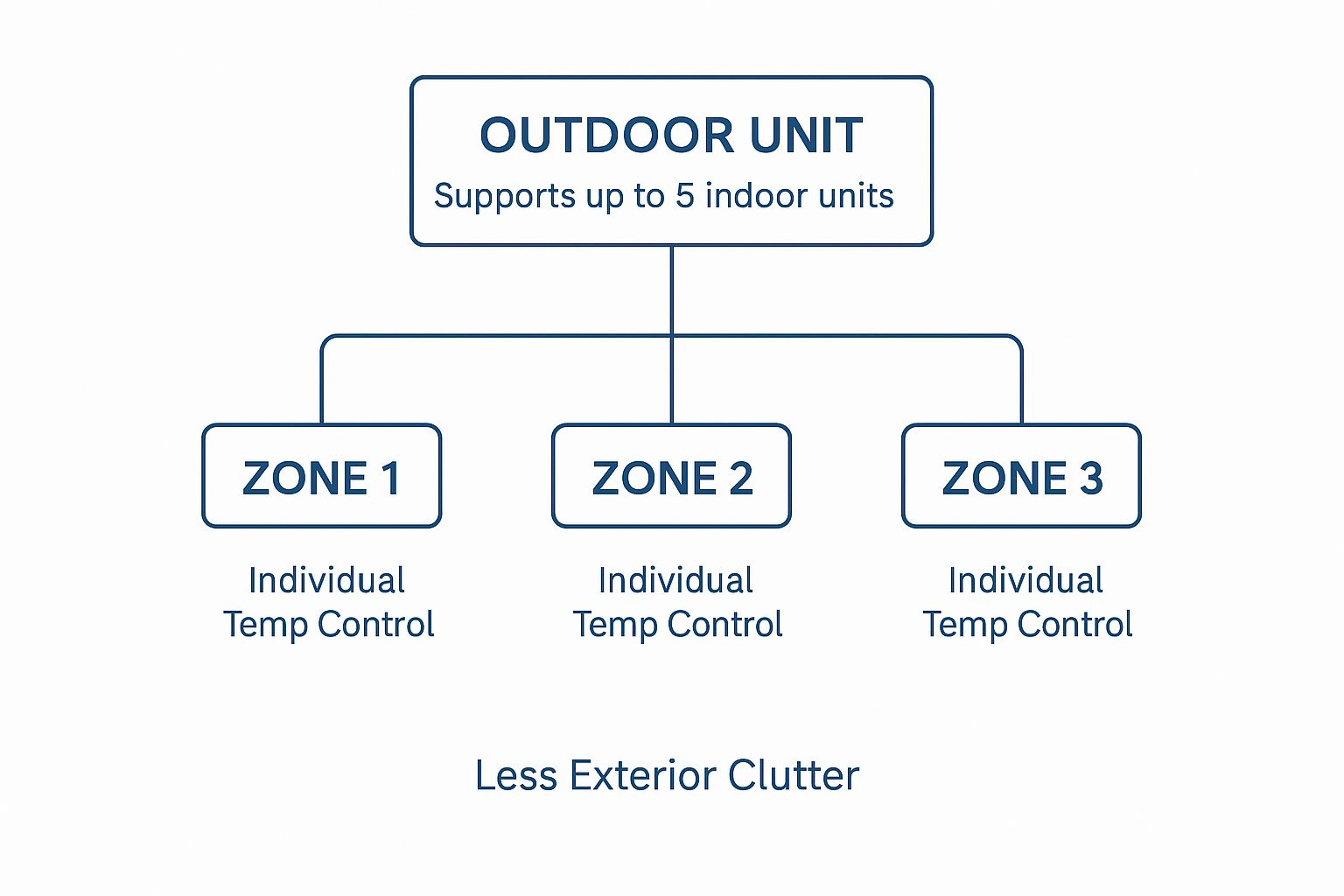
As you can see, it’s a smart design that delivers customized comfort while keeping your building's exterior looking clean and professional.
Ideal Applications in Florida Businesses
In Florida's climate, this kind of control isn't just a nice-to-have; it's often a necessity. The ability to create independent climate zones makes multi-split systems a fantastic fit for a whole range of businesses.
- Small Medical Clinics: Patient waiting rooms can stay comfortably cool, while individual exam rooms are adjusted based on who's in them or what equipment is running.
- Multi-Office Suites: Finally, a solution to the office thermostat wars! Each tenant or department can set their own temperature without bothering anyone else.
- Restaurants: Keep the dining area perfectly chilled for your guests while the kitchen—which generates a ton of heat—gets its own powerful cooling.
The bottom line is individualized comfort without the exterior clutter. You get all the perks of zoned temperature control without the eyesore of multiple outdoor condensers.
Weighing the Pros and Cons
Of course, no system is perfect. While multi-splits offer incredible flexibility, they do have a few things to consider. The upfront cost is usually higher than a single-split system because the outdoor condenser is more powerful and the installation is more involved.
There’s also a single point of potential failure. Because everything is connected to one outdoor unit, if that unit goes down, every single zone it controls goes down with it. That’s a major risk for any business where climate control is mission-critical. Still, for the right business, the superior zone management and energy savings make it a seriously compelling option.
VRF and VRV: The High-Efficiency Champions
When we talk about the top tier of commercial HVAC technology, we're talking about Variable Refrigerant Flow (VRF) and Variable Refrigerant Volume (VRV) systems. These are the most sophisticated and efficient climate control solutions you can get for complex commercial buildings.
You might see both names, but don't get confused—they're essentially the same thing. VRV is simply the term Daikin trademarked years ago, while everyone else in the industry calls it VRF.
Think of it less like a standard AC and more like a smart energy grid for your building. A VRF system circulates only the bare minimum amount of refrigerant needed at any given moment. Its real superpower? It can heat one room while simultaneously cooling another. For large, dynamic properties, that’s a complete game-changer.
This incredible flexibility makes VRF/VRV systems a top choice among the different commercial hvac system types, especially here in Florida. Imagine a building where one side is baking in the sun while the other is in the shade—a VRF system handles that disparity with ease.
How Can It Heat and Cool at the Same Time?
The magic behind a VRF system is its ability to capture and redistribute heat. Let's take a large hotel in Boca Raton as an example. In the afternoon, the guest rooms on the sun-drenched west side need serious cooling. But at the same time, the windowless interior conference rooms might feel a bit chilly.
A VRF system handles this situation brilliantly. Instead of just taking the heat from those sunny rooms and dumping it outside, it intelligently moves that captured thermal energy over to the parts of the building that actually need it.
- Heat Recovery: The system uses a special three-pipe design. This allows it to send hot gas refrigerant for heating and liquid refrigerant for cooling at the same time through different lines.
- Smart Distribution: Every indoor unit has its own electronic valve that acts like a tiny gatekeeper, controlling the refrigerant flow to deliver the exact amount of heating or cooling that specific zone is calling for.
- Centralized Control: One sophisticated outdoor unit manages this whole energy exchange, making sure waste heat gets repurposed, not just thrown away.
This heat recovery process is what makes these systems so incredibly efficient. You’re not paying to create new heat; you’re just moving existing heat from where you don’t want it to where you do. If you're looking to maximize efficiency, our guide on ENERGY STAR HVAC systems is a great next step.
Unmatched Efficiency and Comfort
The "variable" part of VRF is the secret sauce. Old-school systems are either all on or all off, like a light switch. VRF systems are different; they operate more like a dimmer switch. The compressor can run at a whole range of speeds, from very low to full blast, perfectly matching the building's real-time climate needs.
This constant, subtle adjustment avoids the energy-hogging start-and-stop cycles of traditional units. The result? Energy savings of up to 40% in the right building. It also delivers a much more stable and comfortable indoor environment, eliminating the hot and cold spots common with other systems.
The demand for advanced solutions like VRF is a huge reason the commercial HVAC market is booming, with a projected value of $346.7 billion by 2028. Smart controls and sensors are at the heart of this growth. You can read more about the expansion of the commercial HVAC market on custommarketinsights.com.
Ideal Applications for VRF and VRV Systems
Let's be clear: a VRF system is a serious investment. But for the right kind of property, the return on that investment is massive. Their strengths really come to life in buildings with lots of different zones and changing needs.
These systems are an excellent fit for:
- Hotels and Resorts: Each guest wants their own perfect room temperature.
- Hospitals and Healthcare Facilities: Precise climate control is non-negotiable for patient rooms, labs, and operating suites.
- Multi-Tenant Office Buildings: Every business on every floor can control its own climate independently.
- Mixed-Use Developments: Perfectly handles the different needs of retail, office, and residential units all under one roof.
One key thing to remember is that their complexity requires specialized expertise. You need certified technicians for both installation and maintenance. While the upfront cost is higher than other commercial hvac system types, the long-term energy savings and superior comfort often make it a smart financial move for owners of large Florida properties.
Comparing Commercial HVAC System Types
To help you see where VRF/VRV fits in the bigger picture, here's a quick side-by-side look at the main commercial HVAC options. This table gives you a snapshot of what each system does best and what you can expect in terms of cost and performance.
| System Type | Best For | Initial Cost | Energy Efficiency | Key Feature |
|---|---|---|---|---|
| Split Systems | Small offices, retail shops, standalone buildings | Low to Moderate | Good | Simple, familiar technology with separate indoor/outdoor units. |
| Rooftop Packaged Units (RTUs) | Single-story buildings, big-box retail, warehouses | Moderate | Varies (Standard to High) | All-in-one unit housed on the roof, saving indoor space. |
| Chillers & Boiler Systems | Large buildings, campuses, industrial facilities | High | Very High | Uses water to transfer heat/cold, ideal for massive scale. |
| VRF/VRV Systems | Hotels, hospitals, mixed-use buildings, multi-tenant offices | Very High | Exceptional | Simultaneous heating and cooling with precise zone control. |
This comparison should give you a starting point. The best choice always comes down to the specific needs of your building, your budget, and your long-term operational goals.
Rooftop Packaged Units for Large Spaces
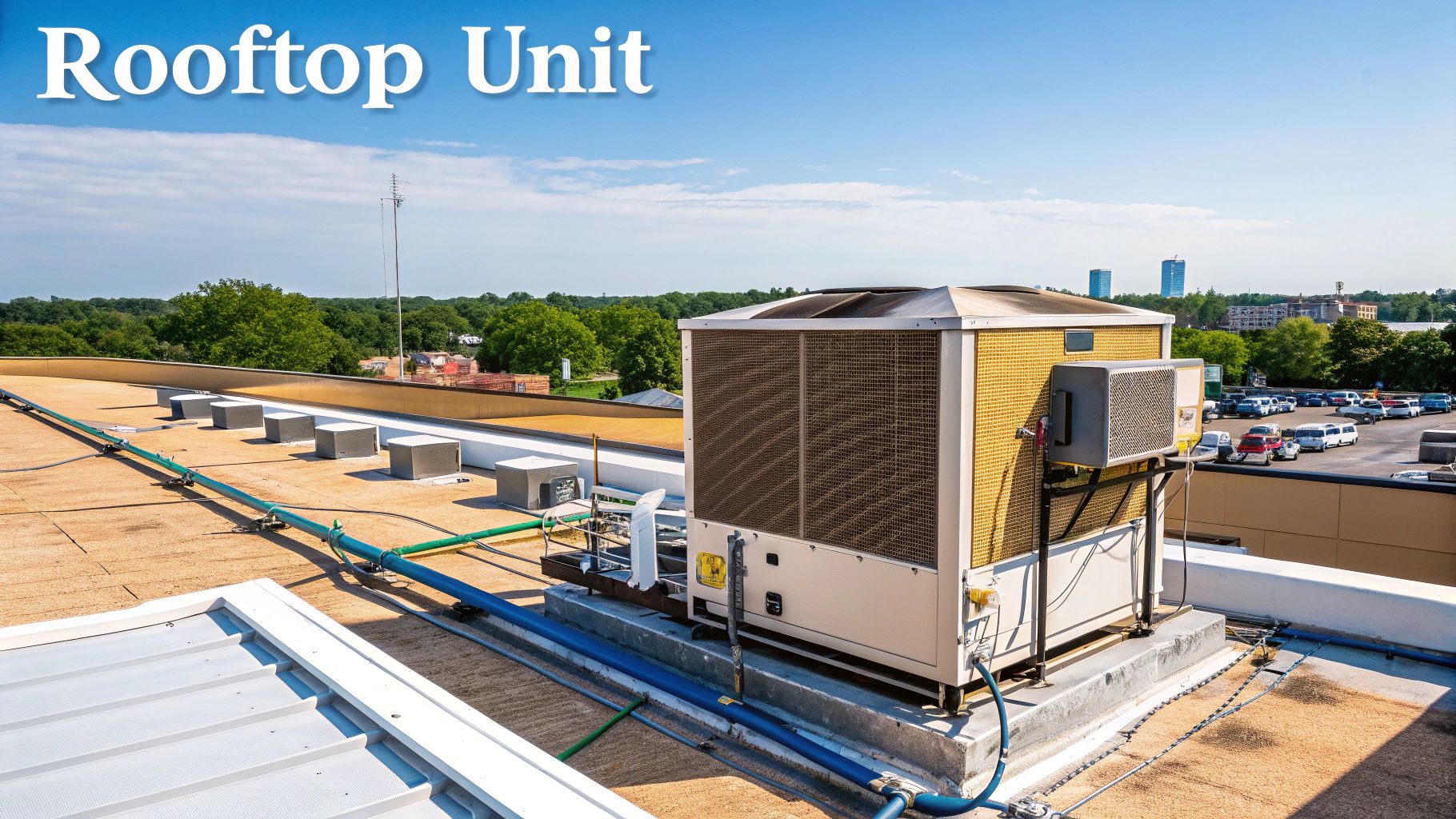
If you've ever looked up at the roof of a big-box store, warehouse, or shopping center, you've probably seen them. Those big, boxy units are Rooftop Packaged Units (RTUs), and they are the undisputed workhorses of the commercial HVAC world. They're a common sight for a good reason—they offer a powerful, all-in-one solution for cooling massive, open-plan spaces.
Think of an RTU as a self-contained climate control powerhouse. Every critical component—the compressor, coils, and air handler—is housed together in a single, rugged cabinet. This consolidated design makes them one of the most practical commercial hvac system types for certain types of buildings.
By placing the entire system on the roof, you immediately free up valuable square footage inside. That's more space for inventory, more room for customers, or more area for your operations. Plus, it keeps maintenance out of sight and out of mind; technicians can work on the unit without ever stepping foot inside your business and disrupting your day.
How These Units Keep Huge Spaces Cool
The real magic of an RTU is its ability to pump a massive volume of conditioned air evenly across a wide-open area. It works by pulling in outdoor air or recycling indoor air, cooling it down, and then powerfully pushing it through a large network of ducts running through the ceiling.
This approach is perfect for buildings with few interior walls, like a grocery store or a distribution center, where the goal is to maintain one consistent temperature everywhere. But this single-source design is also its main limitation. If you need different temperatures in different rooms, an RTU isn't your best bet. It’s built for brute-force cooling, not for creating precise temperature zones.
A well-maintained RTU can easily last 14 years or more, but if you neglect it, that lifespan can plummet to just nine years. Regular check-ups are non-negotiable, especially with the constant beating they take from Florida's sun and humidity.
The extensive ductwork an RTU needs is a huge part of its performance and overall cost. Business owners often underestimate this part of the investment. For a better idea of what to expect, our article offers a full breakdown of the typical hvac ductwork replacement cost.
Key Advantages and Disadvantages
For any Florida business owner with a large property, weighing the pros and cons of an RTU is key to making a smart decision.
Major Benefits of an RTU:
- Saves Space: All the bulky equipment is on the roof, not taking up valuable floor space.
- Simpler Installation: Installing one big unit can be much faster and more straightforward than piecing together a complex indoor system.
- Easy Maintenance Access: Technicians can get their work done on the roof without interrupting your business flow.
- Cost-Effective for Big Areas: When it comes to cooling a large, open building, RTUs deliver a lot of bang for your buck.
Potential Downsides to Consider:
- Limited Zoning: These systems are not built for buildings that need different temperatures in various enclosed rooms.
- Rooftop Hassles: If your roof is steep or the weather is bad, servicing the unit can become a real challenge.
- Weather Exposure: Being constantly exposed to Florida’s intense sun, heavy rain, and potential hurricanes means the unit's cabinet has to be incredibly tough and inspected often.
How to Select the Right HVAC System
Picking the right system from the many commercial hvac system types out there is a huge decision for any Florida business. This isn't just about buying a piece of equipment; it's a long-term investment that directly impacts your energy bills, your employees' comfort, and your bottom line.
Think of it like creating the perfect climate blueprint for your building. Getting it right from the start saves you from a world of expensive problems down the road. The goal isn't just power, but precision. The system needs to be perfectly sized for your space and tough enough to handle everything Florida's weather throws at it.
Your Essential Decision-Making Checklist
Before you even talk to an HVAC professional, run through this list. Having these answers ready will help you get a system that’s actually designed for your business, not just a generic, off-the-shelf solution.
- Building Size and Layout: What’s the total square footage? Are you cooling a massive, open warehouse or a maze of small, private offices? The layout matters just as much as the size.
- Occupancy and Usage: How many people are usually in the building? Does your operation generate a lot of extra heat from things like commercial kitchen equipment or a server room?
- Budgetary Planning: Your budget has to cover more than just the price tag on the unit. You need to factor in installation, any potential ductwork changes, and, of course, the ongoing energy costs.
- Energy Efficiency Goals: Are you trying to get the absolute lowest operating costs possible? Systems with higher SEER (Seasonal Energy Efficiency Ratio) ratings will cost more upfront but save you a lot more money in the long run.
Beyond the unit itself, a successful installation means making sure the HVAC system plays nicely with your building's plumbing, electrical, and structural elements. This requires detailed clash detection and coordination to avoid costly on-site surprises.
Addressing Florida-Specific Challenges
Let's be honest: running an HVAC system in Florida is an extreme sport. It's on the front lines, battling some of the most challenging weather in the country, and your choice needs to reflect that.
The system you choose has to be a dehumidifying powerhouse. Here in Florida, wringing moisture out of the air is just as important as dropping the temperature. A system that's too big will blast cold air, cool the space too quickly, and then shut off—before it has a chance to properly dehumidify. The result? A cool but damp, clammy, and miserable indoor environment.
And don't forget about storm readiness. Rooftop units must be anchored down like they're preparing for a hurricane, and any outdoor components need corrosion-resistant coatings. The salty, humid air here can literally eat metal for breakfast.
Factoring in Long-Term Costs and Global Trends
The initial purchase is just the beginning. The total cost of ownership includes energy bills and, critically, maintenance. Proactive upkeep is the only way to protect your investment and keep it running efficiently. Skipping regular check-ups is a surefire way to shorten a system’s lifespan. To get a better handle on these ongoing expenses, check out our guide on commercial HVAC maintenance cost.
Globally, the entire industry is shifting toward greater efficiency. The Asia Pacific region is now the fastest-growing market for commercial systems, with a projected annual growth rate over 6%. This boom is fueled by government incentives; Singapore, for example, offers tax breaks covering up to 100% of installation costs for high-efficiency equipment. You can read more about these global HVAC market trends on marketsandmarkets.com.
This worldwide focus on efficiency just proves how critical it is to choose a modern, high-performance system. By carefully weighing all these factors, you can confidently select the best of the commercial hvac system types—one that will deliver reliable comfort and lasting value for your Florida business.
Got Questions About Commercial HVAC? We’ve Got Answers.
Stepping into the world of commercial HVAC can feel a bit overwhelming. There's a lot to know, and making the right call is a big deal for your business. To help clear things up, here are some straightforward answers to the questions we hear most often from Florida business owners.
What’s the Real Difference Between Commercial and Residential HVAC?
At first glance, they both just cool the air, right? But underneath the surface, they're worlds apart. The main differences boil down to size, complexity, and where they live. Your home's AC is designed for a simple, single-family layout. Commercial systems, on the other hand, have to tackle huge, complicated spaces with different zones, lots of people coming and going, and massive heat loads.
Think of it this way: a residential unit is like a sedan, while a commercial system is more like a fleet of modular trucks. Commercial units are almost always built in sections, so you can add more capacity as your business grows. You'll usually find them on the roof, which keeps the noise down and frees up valuable ground space. Home AC units are much smaller, all-in-one boxes that sit on a concrete pad next to the house.
How Long Can I Expect a Commercial HVAC System to Last?
This one really depends on you. A commercial HVAC system that's well looked after can easily give you 14 years of solid performance, sometimes even more. Proactive, professional maintenance is the key.
But if you let it slide? That's a different story. A neglected unit, especially one battling the relentless Florida heat and humidity, can give up the ghost in as little as nine years. Regular care isn’t just a good idea; it's the single biggest factor in how long your investment will last.
For Florida businesses, proactive maintenance isn't just a recommendation—it's essential insurance against premature system failure, high energy bills, and unexpected downtime in our demanding climate.
Why Is Regular Maintenance Such a Big Deal in Florida?
Florida's climate is basically a boot camp for HVAC systems. The triple threat of intense heat, sticky humidity, and corrosive salt in the air puts an incredible amount of stress on the equipment.
Consistent maintenance is your system's best defense. It helps by:
- Fighting Off Corrosion: Technicians will clean sensitive parts and spot the early warning signs of damage from salt and moisture before they become big problems.
- Keeping Humidity in Check: When coils get clogged and filters are dirty, your system struggles to pull moisture out of the air. That leaves you with a damp, uncomfortable building and a perfect environment for mold.
- Maximizing Efficiency: A clean, well-tuned system doesn't have to work nearly as hard to do its job. That translates directly to lower energy bills, which is a huge relief during our seemingly endless cooling season.
Can I Just Hire Any HVAC Tech to Work on My Commercial System?
Absolutely not. This is a crucial mistake we see business owners make, and it can be a costly one. Commercial HVAC systems are a whole different beast compared to what you have at home, and they demand a specialized skill set.
A true commercial technician knows how to handle:
- Three-phase electrical power, the standard for most commercial buildings.
- Intricate zoning and control systems, like the brains behind VRF or multi-split setups.
- Massive equipment, including those huge rooftop packaged units that require special tools and strict safety protocols to service.
Bringing in a residential tech to work on your commercial equipment can lead to botched repairs, a voided warranty, and even serious safety risks. You always want to partner with a company that has proven expertise in the different commercial hvac system types. It's the only way to protect your investment and make sure the job gets done right.
Ready to ensure your business stays cool and efficient? The certified professionals at Florida Cooling Group specialize in commercial HVAC installation, repair, and maintenance across Palm Beach County. Contact us today for a consultation and experience the peace of mind that comes with expert service.
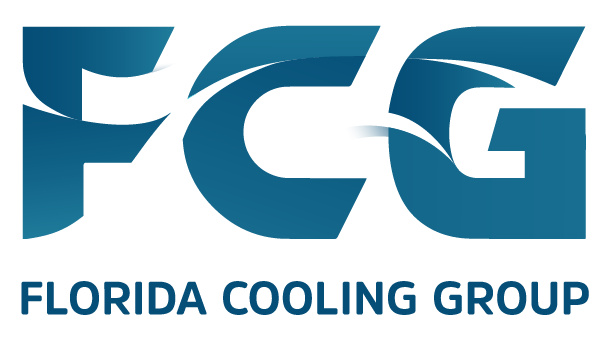
 (561) 400-2205
(561) 400-2205